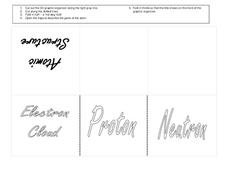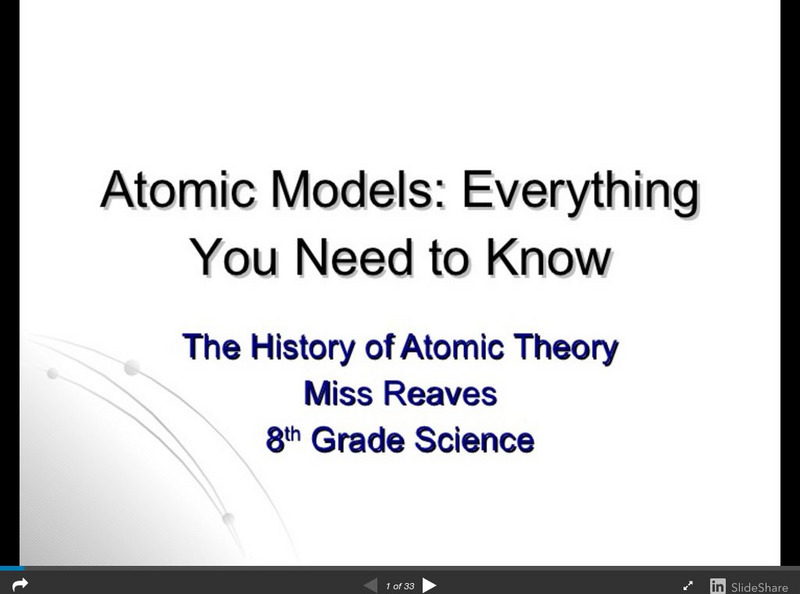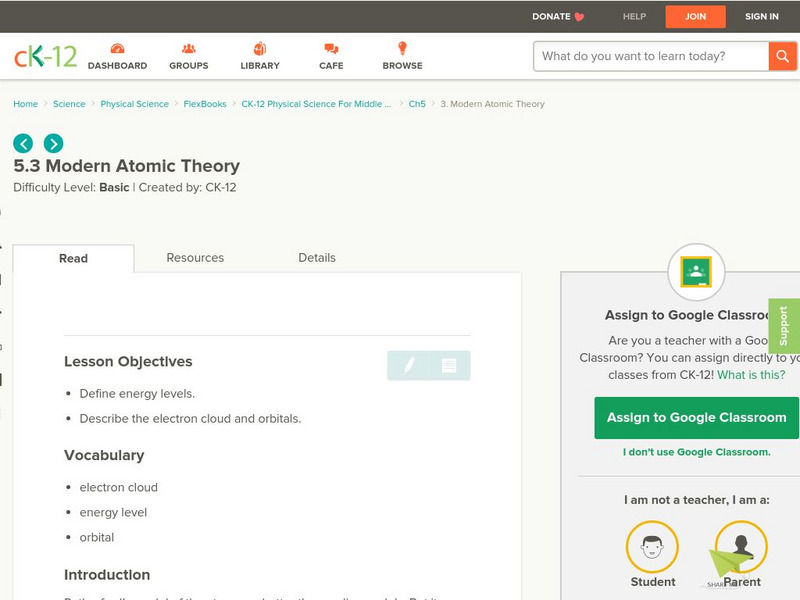Curated OER
The Periodic Table
A huge collection of slides introduces chemistry learners to the periodic table of elements, electron configuration, and electronegativity. It opens with the history of today's periodic table, and then details the arrangement. After...
Curated OER
Timeline of Atomic Models
In this atomic models time line worksheet, students draw a diagram of Democritus, Dalton, Thomson, Rutherford and the Electron Cloud model of the atom.
Curated OER
The Atom
In this atom worksheet, students complete a 3 D graphic organizer for the structure of the atom. They define atomic structure, electron cloud, proton and neutron. They cut out the terms to make flaps with definitions.
Curated OER
Why Do Atoms Combine?
In this atom worksheet, students will complete 8 fill in the blank statements based on the different parts of an atom. Then students will explain how the arrangement of electrons in an atom is related to the periodic table.
American Chemical Society
Middle School Chemistry: Periodic Table and Energy Level Models
Students interpret the information given in the periodic table to describe the arrangement of electrons on the energy levels around an atom.
PBS
Pbs Learning Media: The Structure of Metal
In this interactive activity from the NOVA Web site, animations explain different aspects of the properties of metal.
University of Colorado
University of Colorado: Physics 2000: Elements as Atoms: Electron Clouds and Energy Levels
An explanation of the different types of atomic orbitals, how they are filled according to the Pauli Exclusion Principle, and how many electrons can fit in each electron shell.
Purdue University
Purdue University: Orbital Shells
This site from the Purdue University provides an overview of atomic orbitals and how quantum numbers specify these orbitals. Includes a model that can be rotated and examined in 3D. Includes learning exercises and answers.
Concord Consortium
Concord Consortium: Molecular Workbench: Electrons in Atoms and Molecules
A model that explores why electrons are so important in chemistry. Investigate electron clouds, what happens when two atoms come together, and chemical polarity.
Tom Richey
Slide Share: Atomic Models: Everything You Need to Know
A detailed slideshow for Grade 8 students that looks at the history of our understanding of atoms. Looks at the ideas presented by Democritus, John Dalton, J.J. Thomson, Ernest Rutherford, and Niels Bohr, and the modern-day wave model. A...
CK-12 Foundation
Ck 12: Physical Science: Electron Cloud Atomic Model
[Free Registration/Login may be required to access all resource tools.] Features the electron cloud atomic model and atomic orbitals.
Chem4kids
Chem4 Kids: Atoms: Electrons
Learn about an electron's negative charge, location, and role in bonding. Website also investigates electrons uses in electricity.
Concord Consortium
Concord Consortium: Stem Resources: Electrons in Atoms and Molecules
A module with animations, explanations, and questions about the importance of electrons in the structure of an atom. Understand the definition and locations of electrons in the atom. Explore the role of electrons in bonding, polarity,...
CK-12 Foundation
Ck 12: Modern Atomic Theory
[Free Registration/Login may be required to access all resource tools.] Rutherford's model of the atom was better than earlier models. But it wasn't the last word. Danish physicist Niels Bohr created a more accurate and useful model....
Other
Chemtopics: Atomic Orbitals & Electron Configurations [Pdf]
Solutions to the Schrodinger wave equation give four types of atomic orbitals. Explanation of how quantum numbers specify these orbitals.
Other
Chemtopics: Understanding the Schrodinger Eqn.
The Schrodinger equation specifies atomic orbitals which are occupied by an electron. Quantum numbers can identify a unique energy level for each electron (set up in a PowerPoint presentation).














